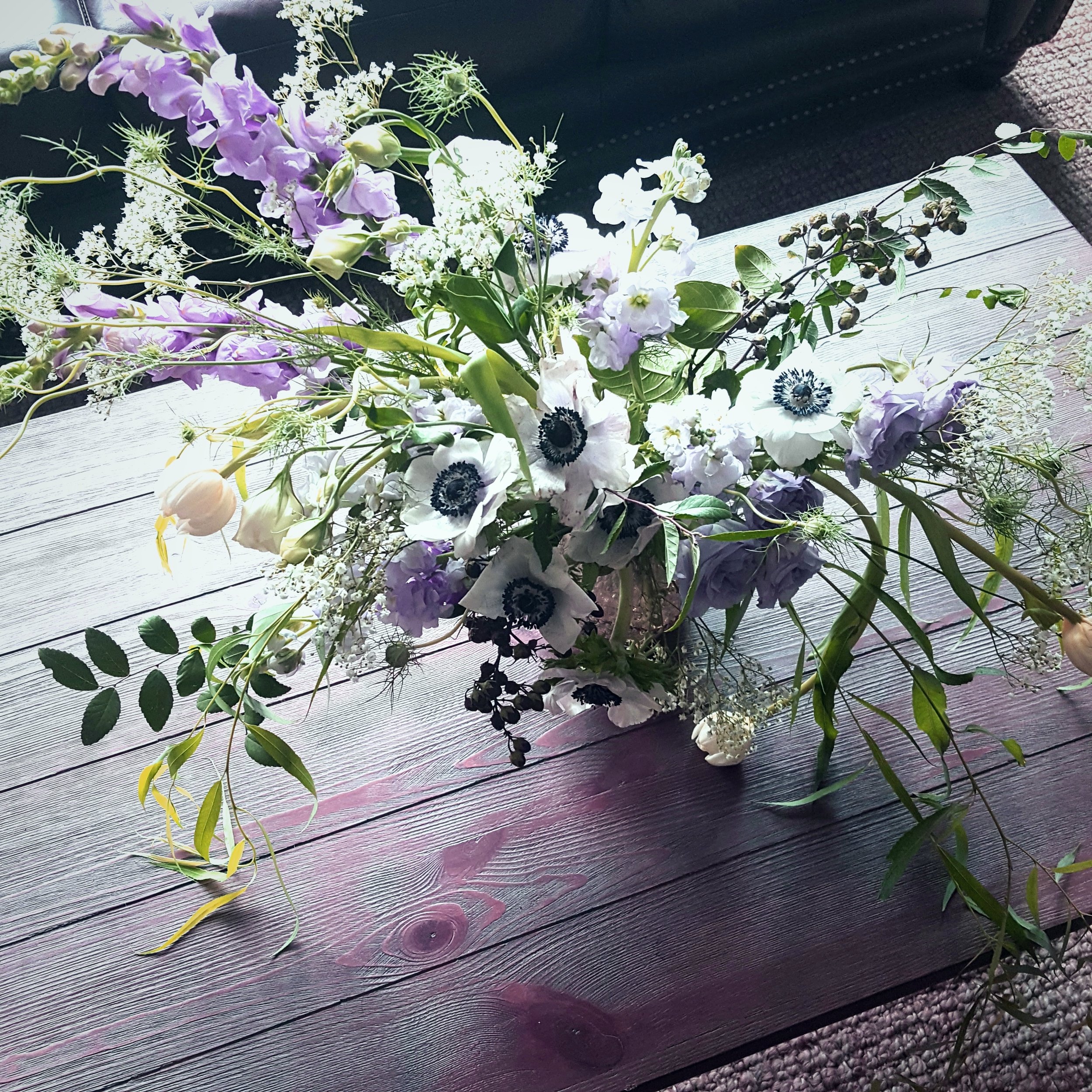Prioritization for the Detail Junkie
Do you rock at the “small stuff?” Are your expense reports always current, your studio bathroom perennially scrubbed, your dinner in the slow cooker by 1 pm, and your inbox read and sorted on the daily?
Because that’s definitely me. As much as the persona of scatterbrained artist holds adorably true for many florists, I know many of us actually live the life described above. We the colloquially OCD love that sense of accomplishment at the end of a completed task, and the small stuff lends itself really well to that. So we stay constantly busy weeding out desk drawers, repainting furniture, color coding spreadsheets…we even go so far as to write down stuff we’ve already done so we can have the dopamine hit of crossing it off our list. (Don’t tell me you haven’t done this.) Our lives and workspaces are hyper-organized, even peaceful.
But when it comes to things like setting yearly or quarterly goals—important tasks that feel less urgent and have fewer immediately tangible outcomes–we get antsy. We can’t seem to function unless our peripheral lives are in order. And since there’s always another administrative chore to do, we routinely let ourselves get lost in the weeds completing those, ever skirting the big visionary stuff.
If you’re nodding sheepishly right now, take it from me: you can totally train yourself to do both in healthier proportion. I’ve been working on my well-disguised procrastination problem for the past six months since taking my floral business full time, so I thought I’d share four strategies that have helped me embrace the conventional wisdom of tackling the Big Stuff first while saving my favorite—all the nitty-gritty loose ends—for second.
Try The Pomodoro Method: Focus for Realistic Intervals
If you’re not familiar with it, the Pomodoro method is a time management technique that uses 30-minute intervals of self-enforced productivity: you work for 25 minutes straight, and then take a five minute break. The anticipation of the break (in which you might even indulge a bribe you set for yourself when you started the timer—a social media notifications check, a quick yoga stretch, whatever) artificially pushes the timeline of reward for finishing the task closer to you, incentivizing quality work in the short term.
The idea is that the more you use the technique, the more your brain develops a capacity for longer work intervals before it feels like it needs the reward. I love the way such a simple structure makes a big or overwhelming task approachable. I used it when I sat down to start this article, and it definitely helped me get an outline out on paper. I can do anything for 25 minutes, right? Right, actually.
There are a bunch of apps that track the traditional 25 minutes on + 5 minutes off cycle, some of which even employ white noise to help create a focused environment. I use one called Tide, which couples the countdown with ambient soundtracks of nature noises. I’ve found this feature surprisingly effective–I often just re-set the 25-minute timer without taking the five-minute break because I’ve slipped into a productive rhythm, and am making headway on the project at hand!
Leave The Room: Initiate a Mental Reset
Speaking of training the mind, Scientific American ran an article in 2011 about a study of the “doorway effect,” espousing that short-term memory gets disrupted when you physically walk into a different room. It’s essentially a sensory data filter your brain employs because whatever happened in the environment you just left will probably be less relevant to the present than the information you’re collecting from the space you’ve just entered. We’ve all experienced this as the somewhat annoying “wait, why did I come downstairs again?” phenomenon, but (hot tip!) you can leverage it to you advantage.
If you find yourself falling down an Instagram rabbit hole or getting wrapped up in a two-hour-long storage closet reorganization while binging on Radio Lab when you know you actually should be sitting down to, say, overhaul your goods and services price list, try literally putting down your phone or the box of tangled bouquet ribbons, and just walking out of the room.
I work from home, so sometimes I even walk straight out of the house to get the mail just to clear my head. As I’m walking back inside, I often articulate a goal to myself: “Ok, I’m going to spend the next 30 minutes jumpstarting that pricing spreadsheet.” Which reinforces the new brainspace I’m entering and gives me an action mandate.
Alternatively, sometimes I pack up only what I need for the project I really want to focus on, and go to a coffee shop or the library. That sounds obvious, but the crucial part is packing only what you need for one project. I’m guilty of habitually over-packing notebooks, books, binders, and technology for an afternoon at the cafe, which just ends up making me feel frazzled by the amount of work I’ve brought, and then disappointed in myself because I didn’t get to all of it in the time I allotted for being off-campus. More often than not, if I can isolate a task, I can make a good dent in it.
Use a Self-Reporting App: Observe Your Own Patterns
Regarding identifying where you’re prone to go off the priority rails in the first place, there is a myriad of data-gathering apps that will prompt you to self-report on pre-determined metrics at random intervals throughout the day. Using a tool like this, especially if you feel like you only have a vague idea of how and where you disproportionately spend your time, can help you mine your life for information, and then use that information to make adjustments.
Choose an iPhone app like Reporter that will send you notifications throughout the day asking you to enter a brief account of what you are doing. For me, reporting exercises revealed that as I made my debut on the floral scene in my city, I spent lots of time carefully researching and planning meet-n-greets for obtaining freelance and booking leads, but very little time physically going out and developing or gaining them. Which, as we all know, is kind of the whole point of being in this business.
I realized that I liked the feeling of control associated with perfecting my game on paper too much to step into the unwieldy real world of clients and colleagues! And I found that I slipped into a frenzy of chores (to avoid taking that risk) after I’d spent more than two consecutive hours planning marketing or outreach. My solution? Limit those planning sessions to one hour each, then contact a minimum of three people with actual inquiries before moving on. In this way, I established a “make contact” precedent for myself, stopped the cycle of over-thinking by simply pursuing people that inspired me, and put the ball in someone else’s court.
So even if the info you initially collect about yourself is embarrassing, it’s good! Telling on ourselves to ourselves is step one of allowing our shortcomings to teach us - especially if our shortcomings masquerade as strengths, or are such a part of the warp and woof of our lives that we don’t recognize them until we decide to study ourselves on the sly.
Work For Your Opposite: Collaborate With Big-Goal Oriented Colleagues
The single best way to balance a detail-focused approach to business is to roll with big-picture people. It allows their mindset and methodology to implicitly critique yours.
I freelance regularly for a couple of other florists in my area who are total bosses at churning out beautiful, well-constructed work but are less concerned than I would be about fussing over perfection. It’s helpful for me to work in their shops because I learn what’s reasonable in terms of time spent on detail inclusion. When we’re, say, preparing two pick-up weddings and one delivery event for the same day, I see how my penchant for personalized boutonniere tags that take 20 minutes a piece to create might be an unrealistic commitment that I need to abandon to major on the majors. Or I learn that I’ve been including an unnecessary amount of specificity in my proposals, and boxing myself into design corners by over-preparing documents. It’s telling…in the most constructive way!
Asking colleagues you trust for feedback on how you can improve is always valuable in moderation. I know that all of us, especially we women, have to be careful not to undersell ourselves or devalue what we bring to the community. So keep that in mind—in the end, you, your colleagues, and your clients hugely benefit from your eye for catching all the tiny things and being on top of your administration and logistics game. Small-stuff junkies also tend to be really good at reading a room and are naturally incredibly thoughtful in their interactions—always a boon. Still, I think there’s no better road to even more self-confidence than being honest about our Achilles heels, and proactively compensating for (even overcoming) them.
So to all my kindred list-checking spirits out there, keep striving to prioritize the big. But keep that running tally of small stuff on hand so you can tackle it like a boss during your five minute Pomodoro breaks. Happy inbox organizing, AND happy long-term planning. You’ve got this.









